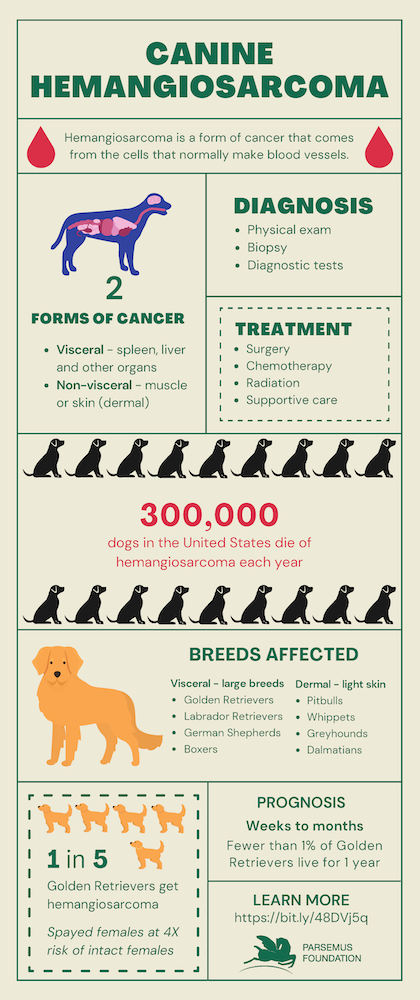A 2023 study on hemangiosarcoma in Golden Retrievers adds to our knowledge of this common canine cancer. As past studies have shown, the occurrence of hemangiosarcoma is related to sterilization status; it occurs much more frequently in spayed females than in intact females. The data come from the Golden Retriever Lifetime Study organized by the Morris Animal Foundation.
What is hemangiosarcoma?
Hemangiosarcoma is an aggressive form of cancer that is often malignant (spreading throughout the body). It comes from cells that normally create blood vessels. This cancer causes blood vessels to branch, fragment, become leaky, and ultimately rupture.
This cancer can be found in any part of the body. Hemangiosarcoma is categorized as visceral (affecting the spleen, liver, heart, lungs, and other organs) or non-visceral (affecting skin or muscle). It is uncommon in humans but quite common in dogs.
Hemangiosarcoma in dogs
Hemangiosarcoma is a serious disease in dogs. According to the American Kennel Club, it’s known as a silent killer because there are often no symptoms until the tumor ruptures and spreads. At that time, it’s usually too late to save the dog’s life. Hemangiosarcoma takes the life of about 300,000 dogs in the United States annually.
Reproductive status is a risk factor for hemangiosarcoma affecting the spleen. Castrated males are more prone to the disease regardless of when they were neutered. Splenic hemangiosarcoma is also more likely to develop in larger dogs including Golden Retrievers, Labrador Retrievers, German Shepherds, Boxers, Cocker Spaniels, and others.
Cutaneous (skin) hemangiosarcoma most commonly affects dogs between 8 and 15 years old, with both males and females affected. Due to the influence of solar radiation on this skin cancer, dogs with lightly pigmented skin are at higher risk. Pitbulls, Whippets, Greyhounds, Boxers, Beagles, and Dalmatians are some of the breeds that are more likely to develop this form of cancer.
More information on the diagnosis and treatment of hemangiosarcoma in dogs can be found here.
Golden Retrievers are highly susceptible to hemangiosarcoma
The Golden Retriever is especially prone to cancer. The Lifetime Study has enrolled over 3,000 dogs, and reports that 60% are affected by cancer. Earlier research including smaller populations also found high levels of cancer in the breed.
The Golden Retriever Lifetime Study data on hemangiosarcoma included 3,044 dogs from the U.S. that were mostly neutered or spayed. Over 7% had been diagnosed with hemangiosarcoma at a median age of about 8 years. Almost 90% of these were visceral, affecting the spleen or heart. Most dogs lived only a short time after diagnosis. Only 1% of dogs with visceral haemangiosarcoma survived for 1 year.
In this study, male dogs (intact and neutered) had a slightly higher chance of being diagnosed with hemangiosarcoma than females. But spayed females had higher rates of both visceral and non-visceral hemangiosarcoma than intact females. This increased incidence in spayed females occurred after 8 years of age. Intact female dogs were least likely to be diagnosed with hemangiosarcoma.
These results confirm previous studies regarding hemangiosarcoma and reproductive status. A 2013 study of Golden Retrievers reported that they were often affected by various cancers and joint disorders. The disease rates differed depending on reproductive status. Cancer and joint problems were significantly increased when neutering was performed early and/or late. In terms of hemangiosarcoma, the percentage of cases in females neutered after 12 months of age (about 8 percent) was 4 times more than intact and early-neutered females.

Should Golden Retrievers be neutered?
Golden Retrievers are beloved family dogs, always ranking as one of the most popular dog breeds in the United States. Unfortunately, the breed is also afflicted by serious diseases like cancers and joint disorders. Given the relationship between health and reproductive status, Golden owners may question whether they should choose conventional spaying or neutering when deciding how to sterilize their pets, and how old their dogs should be when spayed or neutered.
According to a 2020 analysis of cancer, joint disorders, and urinary incontinence in 35 dog breeds that was published in Frontiers in Veterinary Science, the authors recommended that for male Goldens, based on the increased risks of joint disorders and cancers, it is best to delay neutering until beyond a year of age. The suggested guideline for females, based on the increased occurrence of cancers at all spaying ages, is leaving the female intact or spaying at one year and remaining vigilant for the cancers thereafter.
An alternative option is to sterilize males with a vasectomy and females with a hysterectomy. These procedures do not remove the gonads, and thus maintain normal hormone levels for long-term health. Hormone-sparing sterilization offers a reduction in the chances of cancer and joint disorders that are more common in spayed and neutered dogs.
If you have a Golden Retriever or other breed more susceptible to cancer after neutering, learn more about hormone-sparing sterilization options. See our information about hormone-sparing sterilization overview; health effects on dogs of removal of the gonads; and hormone-sparing sterilization procedures.



